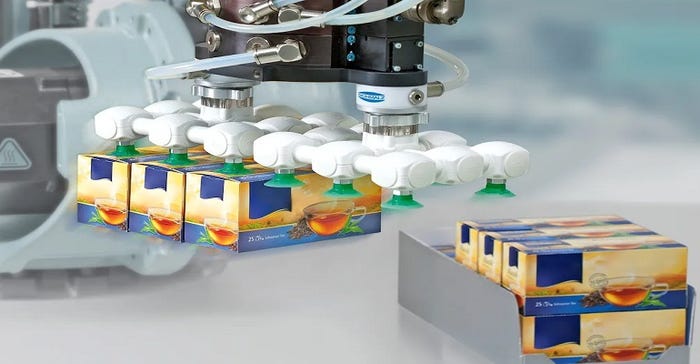End Effector Companies You Should Know
Welcome to the vast world of end-of-arm-tooling for robots. End effectors are the rubber that hits the road in robotics.
June 8, 2023

An end effector – or end-of-arm-tooling (EOAT) – is a peripheral device that attaches to a robot’s wrist. The end effector allows the robot to interact with its task. Most end effectors are mechanical or electromechanical and serve as grippers, process tools, or sensors. They range from simple two-fingered grippers for pick-and-place tasks, vacuum suction cups, or complex sensor systems for robotic inspection.
According to ResearchAndMarkets.com’s Global Robot End Effector Market Report 2022, end effectors will be a $5+ billion market by 2027.
End effectors include robotic grippers, tool changers, collision sensors, rotary connectors, pressure tools, compliance devices, burr cleaning tools, and arc welding torches. These effectors are commonly used for handling, assembling, welding, dispensing, painting, and cutting applications. They are involved in applications across a wide range of industries, including automotive, semiconductor and electronics, food and beverage, metals and machinery, chemical, and healthcare.
Types of End Effectors
According to the robotics trade group, the Association for Advancing Automation, there are so many different types of end effectors that it would be almost impossible to list all of them. However, there are three basic types that you are likely to come across in most situations.
Grippers
The most common robot end effector is the humble gripper. It allows you to pick up and manipulate objects, which makes it best suited to tasks like pick-and-place, assembly, and machine tending.
There are more different types of grippers than there are any other types of end effectors. The most popular are fingered grippers, which come with 2, 3, 4, or 5 fingers — it is possible to use 6 fingers or more. There are also many vacuum grippers, magnetic grippers, and needle grippers.
Process Tools
There are as many different process tools as there are different operations in manufacturing. Examples include, robot welding tools, robot machining tools, robot painting tools, 3D printing tools, and the list goes on and on. If you can do it with a power tool, you can probably do it with a robot. If you can do it with another automated machine, you might be able to do it with a robot.
Sensors
You can also attach a sensor to use the robot as a programmable sensor-orientation device. This is particularly useful for applications like robotic inspection which reduce the amount of hands-on time that inspection engineers need to spend collecting data.
Many sensors can serve as end effectors, including ultrasonic sensors, laser scanners, 2D and 3D cameras, and infrared sensors. Often tool changers are part of the robot, located between the wrist and the end effector. They allow the robot to autonomously change between different tools.
About the Author(s)
You May Also Like




